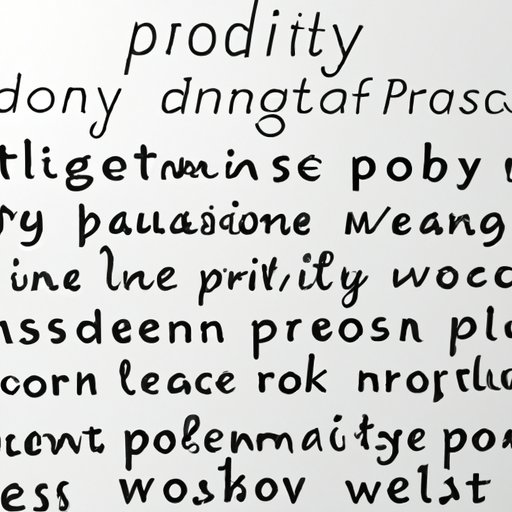Introduction
Writing poetry can seem like an intimidating task for beginners. It is often difficult to know where to start or what steps to take in order to craft a poem. However, it is possible to learn how to write poetry by following some simple steps. In this article, we will explore the basics of getting started with writing poetry, including reading and studying other poems, brainstorming words and phrases, familiarizing yourself with different poetic forms, experimenting with different writing styles, and making use of sensory language.

Start by Reading and Studying Other Poems to Get Inspiration
One of the best ways to get inspired to write your own poetry is to read and study other poets. By reading the work of others, you can gain insight into how they construct their poems and create vivid imagery. You can also learn about different poetic forms and techniques that can help you craft your own unique pieces. As poet Robert Frost once said, “Poetry is what gets lost in translation.” By studying the work of other poets, you can gain a better understanding of the craft and learn how to express yourself more effectively.
When choosing which poems to read, it is important to select ones that are meaningful to you. Pick poems that evoke certain emotions or feelings, such as joy, sorrow, anger, or love. This will help you to connect with the material on a deeper level and gain a better understanding of the art form. Additionally, try to read a variety of different poets and styles, as this will give you a more comprehensive view of the genre.
Brainstorm Words or Phrases That Evoke Emotions or Feelings
Once you have studied the work of other poets, it is time to start crafting your own poetry. Begin by brainstorming words or phrases that evoke certain emotions or feelings. Using emotional language is key to creating powerful poetry, as it helps to draw the reader in and make them feel connected to the material. To find the right words, try to think about specific memories, moments, or experiences that evoke strong emotions. Also, consider making use of similes and metaphors to convey your message in a creative way.
In addition to brainstorming words and phrases, it is also important to consider the tone of your poem. Think about how you want the reader to feel when they read your piece. Are you trying to evoke sadness, anger, or joy? Once you have determined the emotion you are trying to convey, you can then begin to craft your poem accordingly.
Get Familiar With Different Poetic Forms, Such as Haiku and Sonnets
In addition to using emotional language, it is also important to become familiar with different poetic forms. Poetic forms, such as haiku, sonnets, and villanelles, provide structure and organization to your poem, allowing you to create a coherent piece of writing. They also help to add rhythm and flow to your poem, making it easier for the reader to follow along. Additionally, learning different poetic forms can help you to identify which one works best for your particular project.
For example, if you are writing about a specific moment in time, you may want to consider using a haiku. A haiku is a type of Japanese poem consisting of three lines and seventeen syllables, usually focusing on a single image or moment. On the other hand, if you are writing a longer, more complex poem, you may want to consider using a sonnet. A sonnet is a fourteen-line poem written in iambic pentameter and typically follows a specific rhyme scheme.
Experiment With Different Writing Styles, Such as Free Verse and Rhyming
Once you have become familiar with different poetic forms, it is time to start experimenting with different writing styles. Writing styles, such as free verse and rhyming, can help to add depth and complexity to your poem. Free verse is a type of poetry that does not adhere to any particular rhyme or meter, allowing the writer to express themselves freely. On the other hand, rhyming poetry follows a specific rhyme scheme, adding a sense of structure and cohesion to the poem.
When experimenting with different writing styles, it is important to keep in mind that there is no right or wrong way to write a poem. Every poem is unique and should be crafted according to the writer’s individual style and vision. Therefore, it is important to experiment with different writing styles and see which one works best for your particular project.

Make Use of Sensory Language to Create Vivid Imagery
Finally, when writing poetry, it is important to make use of sensory language. Sensory language, such as adjectives, adverbs, and verbs, can help to create vivid imagery and bring your poem to life. For example, instead of simply stating that something is “beautiful,” you could use descriptive language to paint a picture for the reader, such as “The flowers were a vibrant shade of pink that filled the room with warmth.”
Using sensory language also allows you to create a stronger connection with the reader. By providing specific details about the scene or setting, you can help the reader to better visualize the material and become more immersed in the poem. Therefore, when crafting your poem, it is important to make use of sensory language to create vivid imagery and draw the reader in.
Conclusion
Writing poetry can be an intimidating task for beginners. However, by following some simple steps, such as reading and studying other poems, brainstorming words and phrases, familiarizing yourself with different poetic forms, experimenting with different writing styles, and making use of sensory language, you can learn how to write poetry and create powerful, evocative pieces.
(Note: Is this article not meeting your expectations? Do you have knowledge or insights to share? Unlock new opportunities and expand your reach by joining our authors team. Click Registration to join us and share your expertise with our readers.)
